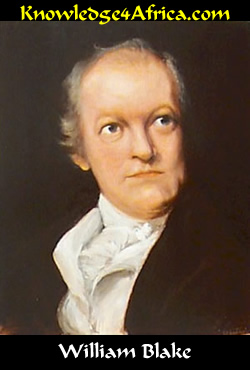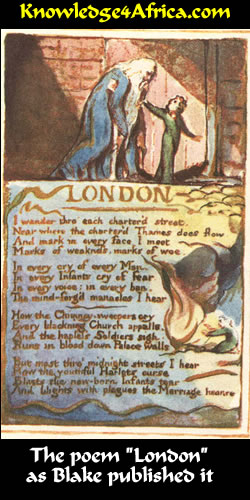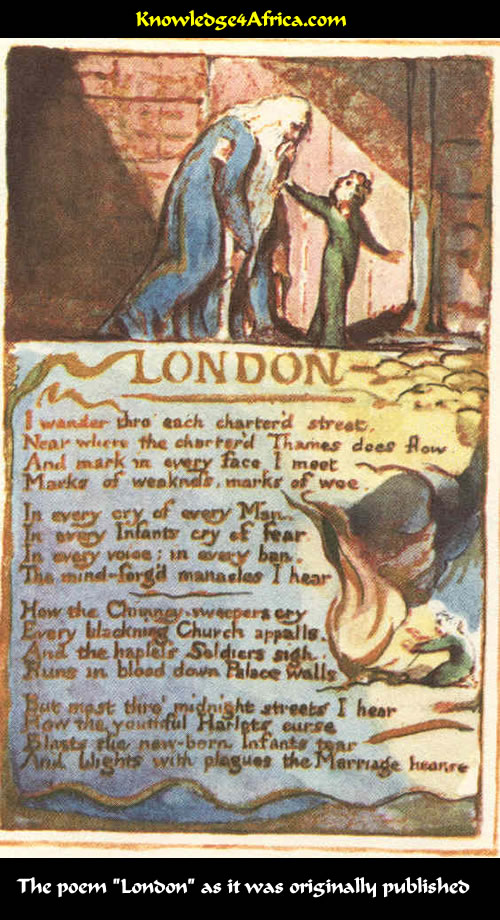|
READ THIS
While wandering through the depressing streets of London, the poet is acutely aware of the
signs of pain,
misery and sorrow in the faces of the people.
In the poem, which is a good example of Blake's social criticism, he refers to the reasons for
their
suffering and the social injustices.
Worst of all is the young prostitute, cursing the newborn baby, and the effect she has on
marriage.
 ABOUT THE POET
ABOUT THE POET
William Blake was born in London in November 1757. He lived most of his life in that city.
When he was 10 years of age, he attended a drawing school and thereafter made engraving
his
profession, graduating from the Royal Academy at the age of 22.
He was then employed as an engraver to a bookseller and publisher, where he was responsible
for
creating the metal picture plates for making illustrations in books.
In 1783, Blake published his first volume of poems and thereafter established his own engraving
business.
This enabled him to publish poetry in a way in which no other poet was doing: by incorporating
his text
into engraved picture plates.
This would have remarkable consequences. First, the pictures were artistic renditions of the
theme and
were not meant to be accurate. Second, each and every picture appeared in a slightly different
shade of
colour so that it is difficult today to determine which colour was the original.
Move your mouse over the picture below to see an example of his engraving for
"London".
Blake's best poems are found in just two collections: Songs of Innocence which he
published in
1789; and Songs of Experience although this was not published on its own.
Indeed, his complete works was published in 1794 and was called Songs of Innocence and
Experience Shewing the Two Contrary States of the Human Soul.
Blake was regarded in his time as very eccentric, if not somewhat mad. In fact, his ideas make
more
sense to us today than they did to his contemporaries.
He was an unorthodox Christian who was heavily influenced by mystical groups. He felt that the
state was
abandoning the needy. Indeed, it is this disillusionment with the suffering he saw in London that
comes
through in this poem.
But what is he trying to tell us? Is it, in the words of his anthology in which this poem was
published,
something about "the Two Contrary States of the Human Soul"?
Blake died in August 1827. He was then 70 years of age.
Have you looked at the questions
in the right column?
|
TEST YOURSELF!
Read the left column and then answer
the following questions:
"I wander thro' each chartr'd street,
Near where the chartr'd Thames does flow."
- The word "chartr'd" is used ironically in this poem. Explain the
irony. (4)

[Need help?]
"Charter" refers to freedom; an enjoyment of liberties granted.
The Londoners whom Blake encounters, however, are restricted and constrained, as illustrated
by words
like "ban" and "mind-forg'd manacles".
The "charter'd" streets, on the other hand, are laid out in a rigid, controlled manner.
There is no
freedom of movement.
Even the River Thames, which should be flowing naturally and freely, appears to be constrained
by the
infrastructure of London.
|
"In every cry of every Man,
In every Infant's cry of fear,
In every voice, in every ban,
The mind-forg'd manacles I hear."
- Fully discuss the effectiveness of the metaphor "the mind-forg'd manacles I
hear". (6)

[Need help?]
The restrictions imposed on people by the Church, the King and government are compared with
chains
which are binding and from which there is no escape.
The inclusion of the word "forg'd" is particularly effective. It means "to be shaped by
heat",
the way a blacksmith would shape horseshoes from heated metal. Blake uses this image to
emphasise
the strength of these restrictions.
The adjective, "mind-forg'd", has two meanings. It implies a restriction on freedom of
thought. It
also refers to people's attitudes.
It implies that the people have become so used to the restrictions, that they impose these
constraints on
themselves. They are so used to the "bans" that they no longer question them, merely
accepting
them as an integral part of their lives.
|
"How the Chimney-sweeper's cry
Every black'ning Church appalls;
And the hapless Soldier's sigh
Runs in blood down Palace walls."
- Discuss the sarcasm in the line "Every blackening Church
appalls". (3)

[Need help?]
Blake's use of the word "appalls" is ironic and conveys his sarcasm. He is critical of the
Church
and its lack of support for the poor and the underprivileged.
The Church is not horrified and does not speak out against social inequality and repression.
The Church
does nothing to alleviate the misery of the poor.
|
- Account for Blake's use of the word "sigh". (3)

[Need help?]
One sighs when one is defeated and feels it is pointless to make any further effort. It is a sign
of
surrender; of giving up and giving in.
The word effectively conveys the hopelessness of the situation facing not only the soldiers but
also the
other poor people. They realise that resistance is futile and they must simply accept their fate.
|
- Discuss the sad irony in the words "Runs in blood down | Palace
walls". (4)

[Need help?]
The blood is running down the walls of the palace. The palace symbolises those who rule:
those who are
the superior authority. This means that the King and the government are responsible for the
bloodshed.
The irony is that a ruler is supposed to protect his citizens, not send them to their doom. Blake
implies
that the King and the government are failing in their moral obligations and abusing their power.
Blake uses this image to accuse those in authority of tyranny and repression.
|
"But most thro' midnight streets I hear
How the youthful Harlot's curse
Blasts the new born Infant's tear,
And blights with plagues the Marriage hearse."
- Consider the connotation of the words "blights" and "plagues", and account
for Blake's
choice of these words. (4)

[Need help?]
To "blight" means to spoil; to harm or destroy; to infect with disease.
"Plagues" are deadly contagious diseases or infestations -- one has only to think of the
devastation caused by the Biblical "Ten Plagues".
Both words have strong connotations of wide-spread, mass destruction from which there is no
escape or
relief. Both words convey the harmful and destructive forces of sexually transmitted diseases.
|
- Discuss why "the youthful Harlot's curse | Blasts the new-born Infant's tear" is such
a shocking
image. (4)

[Need help?]
The prostitute is very young, yet she already has a baby of her own to look after. Instead of
nurturing the
baby, she curses it for crying -- and possibly disturbing her while she is with another customer.
The new-born baby also refers to the offspring of the man -- her customer -- who has
contracted a
sexually transmitted disease from the prostitute. This new-born would also be infected with
(cursed with)
the disease.
A baby is innocent and needs to be comforted. This is a new-born baby, so it is even more
vulnerable,
but it is born into a corrupt, immoral world where it does not receive the love and protection it
deserves.
The question is: what future does this child have if this is the way in which its life begins?
|
- Discuss the effective use of the OXYMORON in the line, "And blights with plagues the
Marriage
hearse". (4)

[Need help?]
An OXYMORON is a combination of contradictory words placed side by side, e.g. bitter sweet.
Marriage is associated with white (virginity): it is supposed to be a celebration of a new
beginning -- the
union between two chaste people embarking on a journey of love together.
Blake has juxtaposed this traditional image with a black hearse, thus suggesting that marriage
implies
death, the consequence of the man visiting prostitutes.
Since the married men have liaisons with prostitutes, the sexual diseases with which they are
infected (in
Blake's time it was syphilis) infect their wives. These diseases could cause death.
A marital union, which is usually associated with promise and joy, meets with a depressing end.
Marriage,
instead of being a union which bears healthy children to perpetuate mankind, is doomed to
failure and
misery from the start.
|
- How would you describe Blake's tone in this poem? (4)

[Need help?]
The poet is angry and cynical. His anger is clearly directed at the King, the government and
Church as
he feels they are responsible for the social injustices and the repression of the underprivileged.
His cynicism is apparent in his attitude towards marriage. His implication is that marriage is not
the happy
state it is meant to be. Marriages are doomed: married men visit prostitutes instead of
remaining faithful
to their wives. Their actions help to spread sexual diseases.
|
This poem was written in 1794. Is it still relevant today? (4)

[Need help?]
This poem still has particular relevance today. The world is still a place of social inequality,
injustice,
exploitation of the weak, poverty and oppression, discrimination against lower classes.
Rulers are still corrupt, using soldiers to fight battles on their behalf, usually to acquire land and
wealth.
The Church is still being accused of corruption, immoral behaviour and sexual abuse of young
boys.
There are many poverty-stricken, desperate people who are exploited by the rich and powerful.
The syphilis of Blake's day has been replaced today by Aids, a far greater plague than syphilis
ever was.
People are still immoral and marriage appears to be a dying institution.
The world Blake describes in his poem has definitely not improved.
|
|





